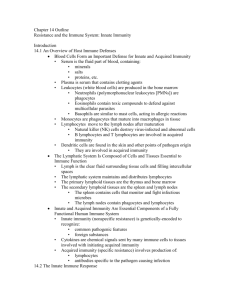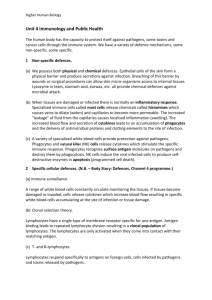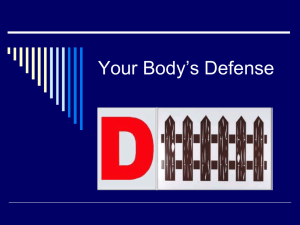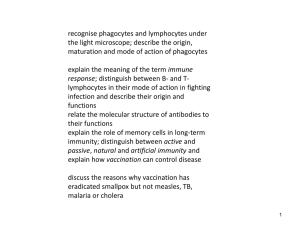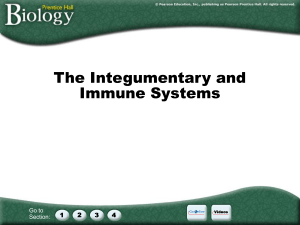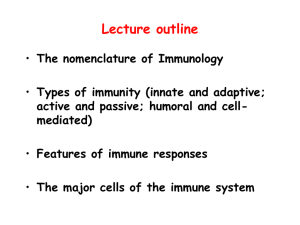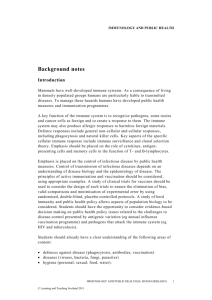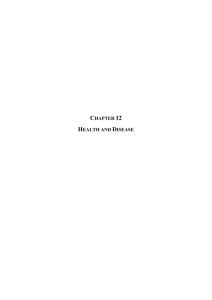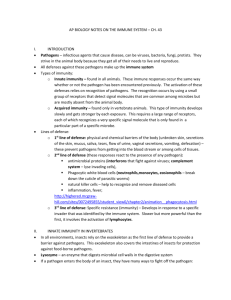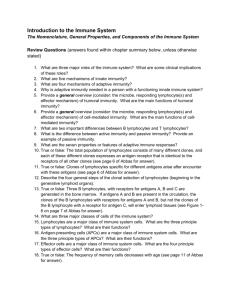Higher Human Biology Outcomes
advertisement
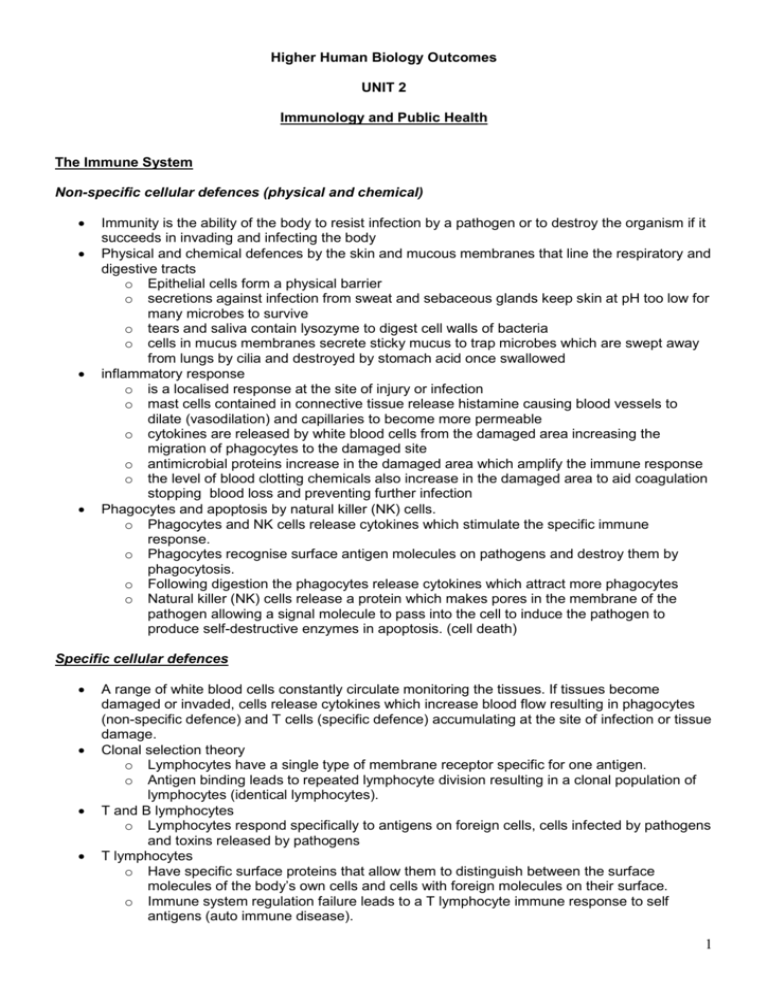
Higher Human Biology Outcomes UNIT 2 Immunology and Public Health The Immune System Non-specific cellular defences (physical and chemical) Immunity is the ability of the body to resist infection by a pathogen or to destroy the organism if it succeeds in invading and infecting the body Physical and chemical defences by the skin and mucous membranes that line the respiratory and digestive tracts o Epithelial cells form a physical barrier o secretions against infection from sweat and sebaceous glands keep skin at pH too low for many microbes to survive o tears and saliva contain lysozyme to digest cell walls of bacteria o cells in mucus membranes secrete sticky mucus to trap microbes which are swept away from lungs by cilia and destroyed by stomach acid once swallowed inflammatory response o is a localised response at the site of injury or infection o mast cells contained in connective tissue release histamine causing blood vessels to dilate (vasodilation) and capillaries to become more permeable o cytokines are released by white blood cells from the damaged area increasing the migration of phagocytes to the damaged site o antimicrobial proteins increase in the damaged area which amplify the immune response o the level of blood clotting chemicals also increase in the damaged area to aid coagulation stopping blood loss and preventing further infection Phagocytes and apoptosis by natural killer (NK) cells. o Phagocytes and NK cells release cytokines which stimulate the specific immune response. o Phagocytes recognise surface antigen molecules on pathogens and destroy them by phagocytosis. o Following digestion the phagocytes release cytokines which attract more phagocytes o Natural killer (NK) cells release a protein which makes pores in the membrane of the pathogen allowing a signal molecule to pass into the cell to induce the pathogen to produce self-destructive enzymes in apoptosis. (cell death) Specific cellular defences A range of white blood cells constantly circulate monitoring the tissues. If tissues become damaged or invaded, cells release cytokines which increase blood flow resulting in phagocytes (non-specific defence) and T cells (specific defence) accumulating at the site of infection or tissue damage. Clonal selection theory o Lymphocytes have a single type of membrane receptor specific for one antigen. o Antigen binding leads to repeated lymphocyte division resulting in a clonal population of lymphocytes (identical lymphocytes). T and B lymphocytes o Lymphocytes respond specifically to antigens on foreign cells, cells infected by pathogens and toxins released by pathogens T lymphocytes o Have specific surface proteins that allow them to distinguish between the surface molecules of the body’s own cells and cells with foreign molecules on their surface. o Immune system regulation failure leads to a T lymphocyte immune response to self antigens (auto immune disease). 1 o Allergy is a hypersensitive B lymphocyte response to an antigen that is normally harmless. o One group of T lymphocytes destroy infected cells by inducing apoptosis. o Another group of T lymphocytes secrete cytokines that activate B lymphocytes and phagocytes. o When pathogens infect tissue, some phagocytes capture the pathogen and display fragments of its antigens on their surface. o Other infected cells in the body also become antigen presenting cells o These antigen presenting cells activate the production of a clone of T lymphocytes that move to the site of infection under the direction of cytokines. o A clone of memory T cells are also produced B lymphocytes o Each B lymphocyte clone produces a specific antibody molecule that will recognise a specific antigen surface molecule on a pathogen or a toxin o Antigen-antibody complexes may inactivate a pathogen or toxin or render it more susceptible to phagocytosis o In other cases the antigen-antibody complex stimulates a response which results in cell lysis. o B lymphocytes activated by antigen presenting cells and T lymphocytes produce a clone of B lymphocytes that secrete antibodies into the lymph and blood where they make their way to the infected area Immunological memory o Some T- and B-lymphocytes produced in response to antigens by clonal selection survive long-term as memory cells. o A secondary exposure to the same antigen rapidly gives rise to a new clone of lymphocytes producing a rapid and greater immunological response. Infectious diseases and epidemiology An infectious disease is one that is capable of being transmitted from one person to another by direct or indirect contact Infectious diseases caused by pathogens can be transmitted by o Direct physical contact e.g. A cold can be caught by shaking the hand of a person who has a cold and who has just used their hand to wipe their dripping nose. o Water e.g. some diseases are caused by drinking water that is contaminated by human or animal faeces, which may contain disease-causing microbes. o Food e.g. Microbes need nutrients for growth and they like to consume the same foods as humans. They can get into our food at any point along the food chain from ‘plough to plate’. Therefore great care must be taken at every stage of food production to ensure that harmful microbes are not allowed to survive and multiply. Microbes can be spread from one food to another during the preparation process, for example by unclean hands, or dirty kitchen utensils, o Body fluids e.g. Hepatitis B and HIV can be spread through sexual intercourse or sharing used syringe needles contaminated with infected blood. Saliva -A cold or the flu can be caught from the saliva of an infected person when you kiss them. o Inhaled air e.g. Measles, mumps and tuberculosis can be spread by coughing or sneezing. A cough or a sneeze can release millions of microbes into the air in droplets of mucus or saliva which can then infect somebody else if they breathe in the infected particles. o vector organisms e.g. Malaria is spread from person to person by certain species of female mosquito carrying the protozoan Plasmodium falciparum Control of infectious disease Quarantine- a period of compulsory isolation. The length of quarantine is planned to match the maximum length of incubation period of the disease 2 Antisepsis- is the inhibition or destruction of microorganisms that cause disease or decay. Procedures such as sterilising equipment, the use of antiseptics on wounds and wearing sterile gloves and surgical gloves individual responsibility o good hygiene such as washing hands, brushing teeth and showering daily o care in sexual health includes the use of condoms to give protection against sexually transmitted diseases o appropriate handling and storage of food Community responsibility o Quality water supply- water is filtered and chlorinated to ensure it is pathogen free o Safe food webs-good manufacturing practise to ensure microorganisms do not enter the food chain e.g. pasteurisation of milk. Inspection, risk analysis and traceability of food sources help to ensure safe food o Appropriate waste disposal mechanisms- Dry waste is collected on a regular basis and recycled, incinerated or buried Control of vectors o E.g. control of malaria- vector mosquito- pathogen protozoan o Draining stagnant water to remove breeding grounds o Introduction of sterile male mosquitoes to reduce breeding rates o Using chemicals such as insecticides and larvicides Epidemiological studies of infectious diseases o Focus on the location associated with its initial outbreak o Its pattern and speed of spread o Its geographical distribution The spread patterns of infectious disease are classified as follows: o Sporadic-occurs in scattered or isolated instances with no connection between them o Endemic-recurs as a regular number of cases in a particular area o Epidemic- simultaneously affects an unusually large number of people in a particular area o Pandemic- occurs as a series of epidemics that spread across whole continents or even throughout the world o Based on epidemiological studies control measures can be considered. o These include preventing transmission, drug therapy, immunisation or a combination of these Active immunisation and vaccination o Immunisation is the process by which a person develops immunity to a disease causing organism o Active immunity refers to the protection gained as a result of the person’s body producing its own antibodies o Active immunity can be developed by vaccination with antigens from infectious pathogens o Antigens from infectious pathogens, usually mixed with an adjuvant to enhance the immune response, include inactivated pathogen toxins (diphtheria and tetanus), dead pathogens (hepatitis A and poliomyelitis), parts of pathogens (hepatitis b and HPV) and weakened pathogens (rubella, mumps and measles). Vaccine clinical trials Vaccines are subjected to clinical trials in the same way as other pharmaceutical medicines to establish their safety and efficacy before being licensed for use. o Clinical trials use randomised, double-blind, placebo-controlled protocols. o Double blind trial is one in which neither the researcher nor the subject know who is receiving what. This eliminates bias o Subjects are split into groups in a randomised way o One group of subjects receives the vaccine, while the second group receives a placebo control to ensure valid comparisons. o At the end of the trial, results from the two groups, which must be of a suitable size to reduce the magnitude of experimental error are compared to determine whether there are any statistically significant differences between the groups. 3 Herd immunity and antigenic variation Herd immunity is a form of immunity that occurs when the vaccination of a significant portion of a population (or herd) provides a measure of protection for individuals without immunity as it is difficult for a disease to spread because there are so few susceptible people to infect This herd immunity is important in reducing the spread of diseases and in protecting vulnerable and non-vaccinated individuals. The percentage of immune individuals in a population above which a disease no longer manages to persist is called the herd immunity threshold Its value varies from disease to disease and depends on factors such as o Virulence of the pathogen o The vaccines efficacy (effectiveness) o The population’s contact parameters (degree of population density that affects the pathogen’s ability to spread) Public health immunisation programmes o In most countries, policy in public health medicine is to establish herd immunity to a number of diseases. o Difficulties can arise when widespread vaccination is not possible due to malnutrition and poverty (the developing world), or when vaccines are rejected by a percentage of the population (the developed world). The evasion of specific immune responses by pathogens. o Many pathogens have evolved mechanisms that evade the specific immune system which has consequences for vaccination strategies o Some pathogens can change their antigens, making them different from the original strain, avoiding the effect of immunological memory o Antigenic variation occurs in diseases like malaria and trypanosomiasis (sleeping sickness) and is one of the reasons why they are still so common in many parts of the world. o Antigenic variation also occurs in the influenza virus explaining why it remains a major public health problem and why at risk individuals require to be vaccinated every year. Direct attack on the immune system o The absence or failure of some component of the immune system results in increased susceptibility to infection. o HIV attacks lymphocytes ( helper T cells) reducing their numbers o HIV is a major cause of acquired immunodeficiency disease (AIDS) in adults o As a persons helper T cell number drops the body’s immunological activity decreases leaving the person susceptible to opportunistic infections o Tuberculosis (TB) survives within phagocytes. When the macrophage engulfs the bacterium into a vesicle the microbe releases molecules that are thought to modify lysosomal membranes and prevent them from fusing with the vesicle o If the lysosomal enzymes are released the microbe is protected by a waxy cell wall. The pathogen therefore remains alive inside the macrophage and avoids detection by the immune system 4

